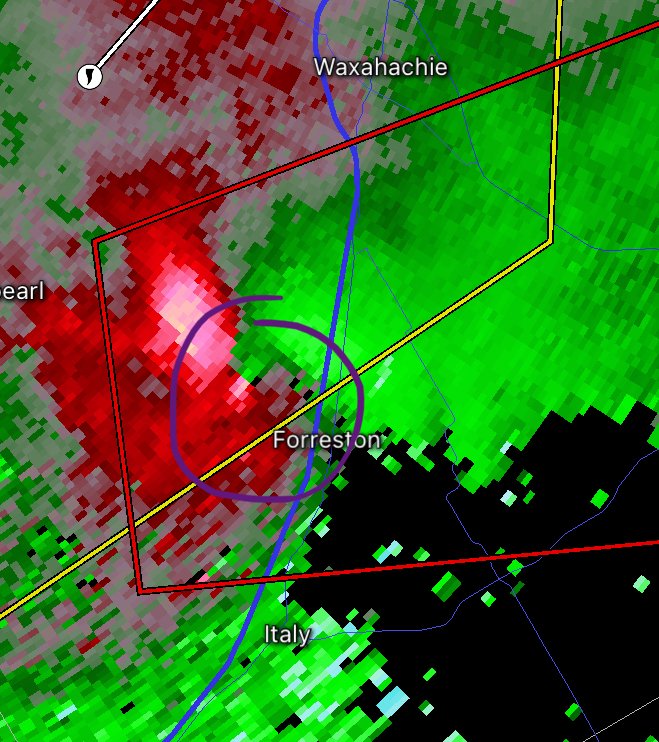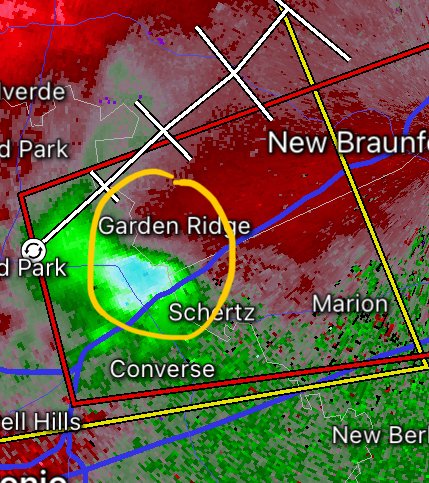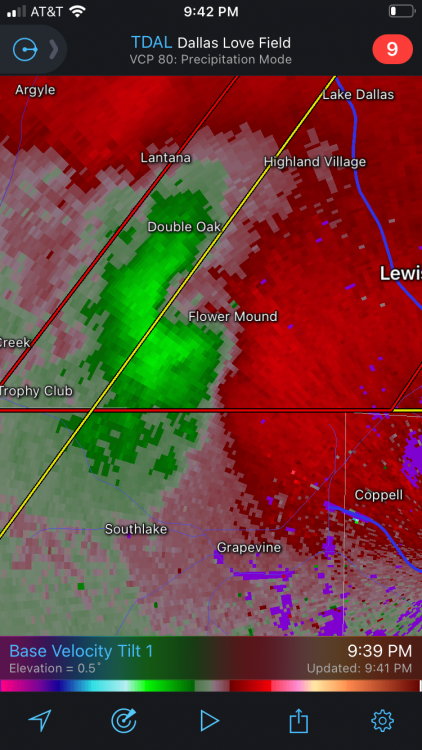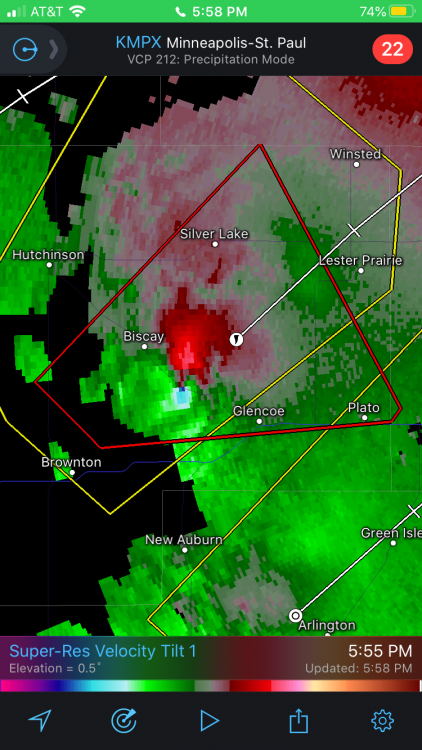-
Posts
507 -
Joined
-
Last visited
Content Type
Profiles
Blogs
Forums
American Weather
Media Demo
Store
Gallery
Posts posted by Sydney Claridge
-
-
That now-severe storm northeast of Denton seemed to blow up out of nowhere. Though very minor right now, radar seems to suggest additional attempts at initiation SW of Decatur.
-
Storm northeast of Denton (around Pilot Point) might need a warning soon; it seems hail sizes are coming up.
Also there seems to be a notch on that storm over Mesquite. Fortunately it seems there is very little rotation however. -
-
-
7 minutes ago, TexMexWx said:
Wonder if the updraft will be able to sustain itself, especially with some dry air still in the lower levels of the atmosphere per the recent FWD sounding
What I saw driving home from work had quite a high base; I wonder if this updraft is rooted above the cap?
-
17 hours ago, beavis1729 said:
An already impressive winter in interior Alaska is going out with a bang, with snow and cold. 2-day snowfall of 13.2" on April 3-4 in Fairbanks, which brought the snow depth to 40". This is the highest snow depth since 1993. Snow depth on 4/7/2021 was still 38", 2nd highest so late in the season (only 1991 was greater). Could be a bad year for flooding and river ice break-up.
Fairbanks just set a new record for consecutive days under 40F:
(1) 179 days: 10/11/2020 to 4/7/2021 - still active
(2) 176 days: 10/3/1965 to 3/27/1966
(3) 171 days: 10/8/1994 to 3/27/1995
With clear skies and fresh snow cover, Fairbanks dropped to -24 on 4/6/2021, which is the 3rd coldest temp on record so late in the season (-24 on 4/7/1986 and -32 on 4/10/1911). It was even colder at some other sites: -36 at Jim River DOT (Mile 138 Dalton Highway); -34 Norutak Lake RAWS; -33 Bettles.
There is an even colder airmass lurking for this upcoming weekend, where Fairbanks could hit -25 or -30. Normal temps for this weekend are 40/16. Per Rick Thoman: "By several measures, the Utqiaġvik 00Z Thu RAOB records the coldest April low-level airmass on record (since 1948). Lowest 850mb temp -35.5C; lowest 1000-850mb thickness 1138 gpm; lowest 1000-500mb thickness 4803 gpm."
http://ak-wx.blogspot.com/2021/04/even-colder-on-way.html
http://ak-wx.blogspot.com/2021/04/extreme-cold-approaches.html
It’s crazy to see such cold temperatures there so late, although definitely not unprecedented as their April record low is -32F. Climatically speaking, Fairbanks has very little seasonal lag. This means that in Fairbanks, June is warmer than August, and December is colder than February.
It looks like temperatures return to normal next week, and that streak of below 40F temperatures will come to an end.
-
1 minute ago, kayman said:
For once in my lifetime, the Atlanta TV news operations are covering their 2 eastern Alabama counties within their TV market area for severe weather. All of the Atlanta TV stations are covering this major supercell with a TDS on NWS radar
Speaking of Atlanta, if this storm can hold together that long, it might try to make a run at the southern portion of the Atlanta metro area. That would be very concerning.
-
 2
2
-
-
-
I'm going to get more concerned for a severe storm threat here in the Metroplex if the dewpoints can continue to rise into the 60s. The southern and eastern sections have already seen this happen, and there is additional storm activity forming to the west as well (between DFW and Abilene, but those storms appear to be elevated and behind the surface front).
-
1 hour ago, Bob's Burgers said:
SPC might have to bring the Slight all the way to Dayton Ohio
Given that several models show intensification of the low pressure over Illinois and Indiana (eg. GFS, Euro, 0z HRRR), I would definitely agree with that sentiment, if primarily out of concern for damaging straight-line winds (and while not related to SPC criteria, perhaps for non-thunderstorm winds too, especially in IN/OH, in the event of a particularly-strong low). Some of these models also have lower-60s dew points getting north of the Ohio River, even as far north as the I-70 corridor (Indianapolis-Dayton-Columbus) in some runs. SPC even hinted at QLCS potential for the Ohio Valley (KY/IN/OH) as well.
If more destabilization and warmer temperatures/dews (than what models currently show) can get that far north, I would be concerned for a more widespread severe thunderstorm outbreak than what is currently expected. It appears as if that all comes down to the amount of "junk" precipitation that forms, as less would mean more supercell (and tornado) potential and potentially a greater spatial extent to any potential outbreak. If things stay "junky," then whatever tornado potential remains might appear confined to MS/AL, but less junk would increase potential in MS/AL plus bring more severe storm action into the TN and OH valleys. -
15 minutes ago, David Reimer said:
Perhaps I wasn't being sarcastic after all. One of those failure modes came to fruition this evening. There were certainly several tornadoes this afternoon in portions of Mississippi and Alabama. A few of them were significant (EF2+). Was today a 'high risk caliper event'? I'm leaning towards no. I don't fault the 06Z forecaster as their small high risk was placed alright. The 45% tornado late this morning and the continuation of the high risk at 01Z? You've got to be freaking kidding me. There's a rain shield with a few lightning strikes blasting across that 01Z high risk. There aren't even any severe storms in the rain shield! I'm afraid today will add a 'crying wolf' syndrome to some residents in those regions. They sure haven't forgotten April 27, 2011 - but we're coming up on the ten year anniversary. Today's tornado probabilities were identical to those on April 27, 2011. I don't expect every high risk to be a generational outbreak, but I sure do expect more than what we got today. One long-track tornado does not verify a 'high risk'. One EF2+ tornado does not verify a high risk (although I bet we do see at least two from this afternoon's activity).
There was definitely a lot of tornado potential today that was (fortunately) not realized. Definitely there were a few strong tornadoes, but the ceiling was a lot higher. If today counts as a bust, then it reminds me a little bit (but for different reasons) of May 20, 2019, which also had a 45% hatched tornado risk, but outside of one or two supercells, was a bust.
Tornado season is only just starting. I’m still concerned about the potential for one (or more) significant tornado outbreaks later this spring.
-
 3
3
-
-
13 minutes ago, cheese007 said:
First tor warning southeast of Dalhart
Interestingly surface temperatures seem a bit cool in that area, but higher elevations don't need the same temperatures and dewpoints as lower elevations to get the same amount of SBCAPE, either. Temperatures on the SE side of that storm are in the mid-to-upper 50s, but it seems like 40s are closer to the storm.
-
We have a MDT for 15% hatched tornado probabilities now.
I think this is the first MDT of 2021 so far (I might be mistaken though). Seems like tornado season is starting to ramp up, especially if that MDT verifies.
-
 1
1
-
-
9 hours ago, Indystorm said:
So far this season a number of parameters are similar to 2011.....slow start to season and low number of tornadoes.....moderate La Nina, cold outbreak in far southern regions. I am somewhat apprehensive about what this spring may bring.
That is exactly what worries me about this tornado season. Once things start to ramp up I am concerned that we will have some dangerous tornado outbreaks. I highly doubt we will have a tornado season as extreme as 2011, given that 2011 was essentially a “worst-case” scenario, but you can never rule that out, either.
A more “tame” severe weather event (no severe storm is “tame” though), such as what might happen this upcoming weekend, might help get people into the mindset of severe weather preparedness and away from complacency, before the truly dangerous stuff comes along.
-
8 minutes ago, andyhb said:
This.
Ignoring what weather weenies like us want in favor of what is simpler for the public to understand is the whole purpose of working with social scientists. I don't see any need to trash this decision until we see actual results from the change.
I agree. The public at large needs straightforward messaging that helps them best understand what the hazard(s) are. The government does not (and should not) expect everyone to understand the technical terminology used in severe weather warnings, watches, or advisories.
I'm a weather hobbyist who understands some of this terminology, but my formal college education is in the social sciences. So much focus is on the difference between a watch (be prepared for the hazard) and a warning (take appropriate action). My understanding is that advisories refer to hazards that are below "severe" criteria (eg. winter, thunderstorm, flood, etc.). If there is a more effective way to communicate that to the public, then that is what should be done.
-
21 hours ago, TexMexWx said:
With our luck, D4 is also gonna be a dreary rainy/misty/cloudy day.
In all seriousness, I'm intrigued by the setup. Still some uncertainties, as noted by the SPC in their outlook (cap, degree of surface-based instability, etc.)
On the Day 3 outlook, SPC removed all mention of severe thunderstorm potential for Sunday. Seems like those uncertainties might have won out.
-
 1
1
-
-
Aside from a few warnings here and there, this was a complete bust. There were no severe weather reports at all per SPC (at the time of this post), quite surprising for a day that started out with an Enhanced risk (and a 10% tornado contour), albeit this was later downgraded.
-
Spring 2020 was interesting, with a particularly intense period in April, but tornadic activity dropped off pretty quickly after that, with a quiet autumn to boot.
I'm going to assume that 2021 could be an intense season, with a La Niña currently in place. I know that a transitioning La Niña favors an uptick in tornadic activity in the Southern Plains (Texas-Oklahoma), but that Dixie Alley and the Ohio Valley often see increased activity in cases of a resurgent La Niña (see "US regional tornado outbreaks and their links to spring ENSO phases and North Atlantic SST variability" by Lee et al.). Forecast precipitation anomalies seem to show increased precipitation in the Ohio Valley in particular.
I'm going to place my bets on an active 2021 season for Dixie Alley and the Ohio Valley.-
 1
1
-
-
42 minutes ago, TexMexWx said:
Storms off the Texas coast have some rotation already, but it also looks like they might be moving almost due north (heading towards or a little east of the Houston metro). Regardless, they have special marine warnings on them for waterspout threats.
There’s quite the temperature divide across the Houston metro this morning, with 50s in the far west suburbs (Katy), with 40s not too much further west, but generally upper 60s over the rest of the metro. Definitely cannot rule out severe storms in the Houston area until the front passes through (which it should do in the next few hours as the storm system moves NE).
The storm coming ashore at Surfside Beach looks slightly isolated and now has a severe thunderstorm warning with “tornado possible” wording indicated.
-
58 minutes ago, cheese007 said:
Had a brief tor warning up in Denton. Can't say I saw that coming on a marginal risk day
We actually had some favorable values (EHI, SigTor, VTP) earlier that showed up on the SPC Mesoanalysis between DFW and the Red River. Some of those values were pretty high (there were VTPs exceeding 9, for instance) before the storms came through, so I’m not surprised at all that there were a few tornado-warned storms.
-
3 minutes ago, purduewx80 said:
unfortunately, eating healthy and having enough time to exercise is a privilege in this country, thanks largely to capitalism. helps explain why people of color have suffered the most this year.
No wonder why COVID has preyed on this country so much. None of our politicians seem to have the chutzpah to rein in the junk food industry, and the false narrative of "personal choice" (look up "food deserts") continues to be an issue. As much as I hate to say it, our country was primed for a pandemic that would come in, spread, and take advantage of the large number of people who are overweight or obese.
Our healthcare system was apparently designed to deal with acute illnesses, and fails miserably at the treatment and prevention of certain chronic illnesses ("pre-existing conditions") that can contribute to severe cases of COVID. Preventing things like this in the future might require a full-on "War on Obesity," and politicians (and others) will have to make many hard decisions (and challenge the powerful junk-food lobby) should they follow this path.-
 1
1
-
-
Not even a 2% tornado risk today but yet we are currently seeing tornado warnings north of Columbus, OH. This does include Franklin County, generally the northeastern part around New Albany. It surprised me when I noticed said warnings.
-
NBC4 Washington on-air met thinks a tornado warning may be coming in for DC soon, hook over NW DC. I did notice an outflow boundary on radar earlier west of Arlington/south of McLean along I-66, however.
-
 1
1
-
-







General severe weather discussion
in Central/Western States
Posted
Apparently there was "significant tree damage" at Goar Park in University Park according to NWS storm reports. Also a home got damaged on Northhaven Road across from North Haven Gardens, which was an area hit hard back on October 20, 2019.